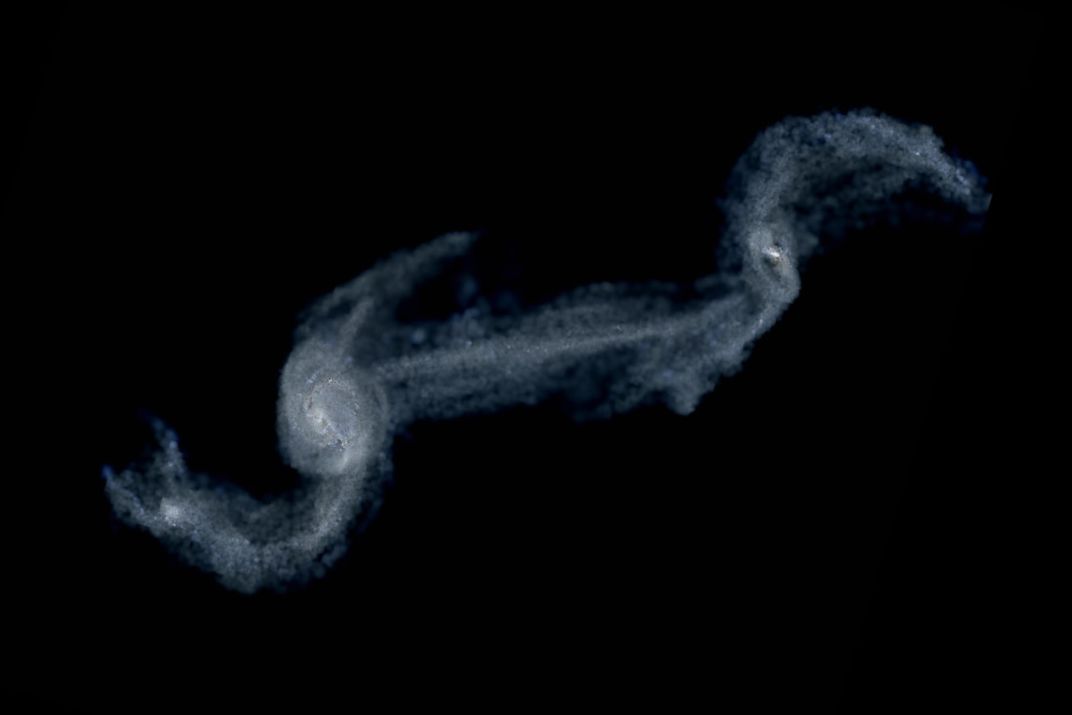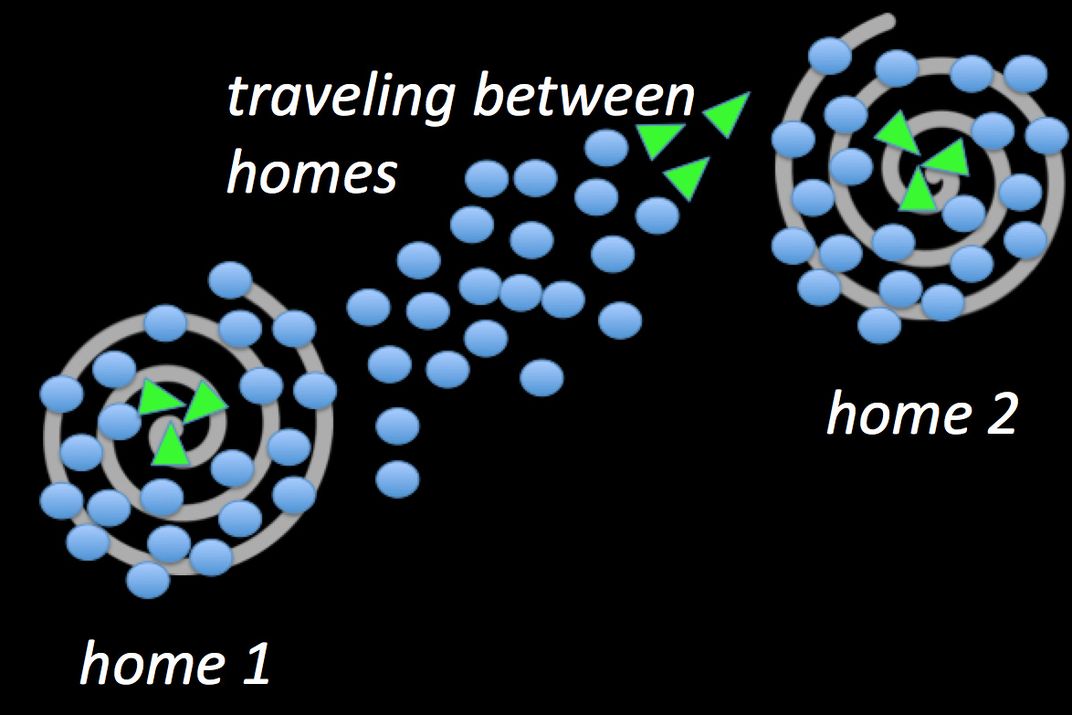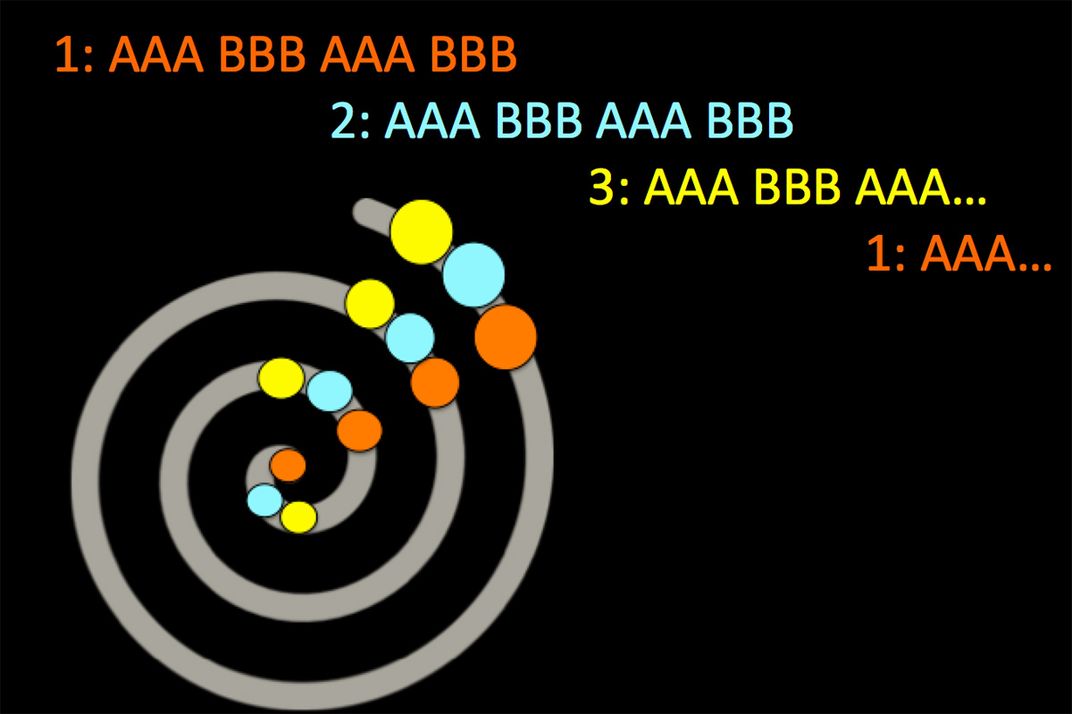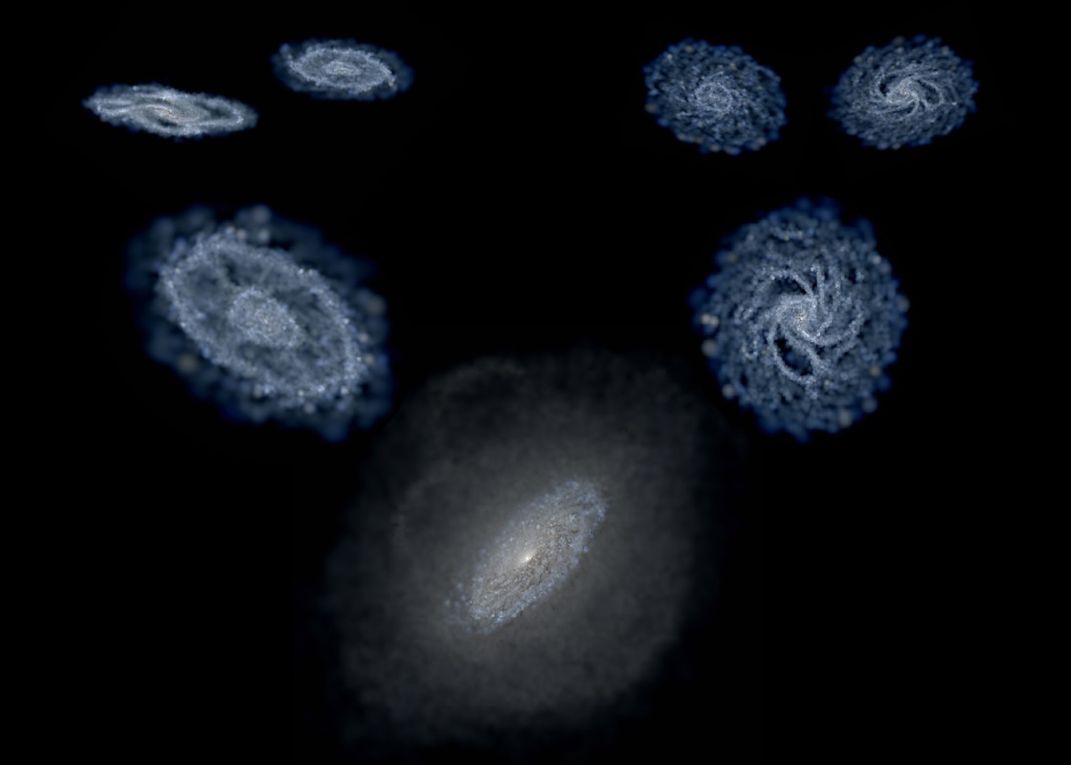Andean Solstice Celebrations Capture the Wondrous Churn of Spacetime
Exploring the similarities and differences between Indigenous and Western cosmologies
/https://tf-cmsv2-smithsonianmag-media.s3.amazonaws.com/filer/77/5f/775f3ae2-3673-4e35-96c5-f84fb2917ae4/fig-1c-dancing-at-the-church.jpg)
Today on the summer solstice, millions of people all over the world celebrate this celestial holiday in unique cultural ways. In the northern hemisphere, the summer solstice usually occurs on June 21, when the Earth’s northern pole is at its maximum tilt toward the sun.
One way that this midsummer event is celebrated in Ecuador is Hatun Puncha (also called Inti Raymi), a time when Kichwa-Otavaleños (Indigenous people from the northern Andes) gather to make music and dance. The music lasts for several days, and musician-dancers follow a special spiral pattern as they move from one village house to the next.
Jorge and I are professors in fields of study that may seem galaxies apart. Although he’s a theoretical astrophysicist and I’m an ethnomusicologist, our shared identities as new Latinx university faculty drew us together. To support each other’s efforts, we frequently meet at local coffeehouses for afternoon espresso breaks. One day when I arrived, Jorge was writing computer code to simulate galaxy mergers. While we stood in line, we talked about Jorge’s figures and videos, which looked surprisingly similar to dance formations I observed during Hatun Puncha.
My fieldwork partners in Kotama explained to me that Kichwa-Otavaleño transverse flute music and spiral dancing represent the motion of celestial bodies and people’s relationships with Pachamama (Mother Spacetime). I was interested in exploring what connections, if any, an astrophysicist would notice. Both of us are interested in ways that opening interdisciplinary dialogue between the sciences, humanities, and Indigenous knowledge systems could help build stronger understandings of the world around us.
Here we decided to share our conversation, bringing in charts and other media to explain each of our views of spacetime.


How Do You Describe “Pachamama”?
Jorge: I’ve heard the Kichwa word Pachamama translated into English as “Mother Earth.” Is that so?
Jessie: Kichwa is an Indigenous Quechuan language (not a dialect) primarily spoken in Ecuador; it is related to languages spoken across South America. “Pachamama” is an excellent example of a term that proves difficult to directly translate to another language. For example, let’s break the word into its two parts. Mama is a more straightforward term that means mother. Pacha is trickier to interpret. It may serve as a prefix, suffix, or stand-alone noun that has several uses in Kichwa, such as an adjective, adverb, or superlative describing the quantity or quality of something.
Sumakpacha may mean that something is very beautiful (literally “beautiful very”). It may also function as a noun related to a specific hour (e.g., 10 a.m., or chunka pacha), period (spring time, or sisay pacha), or dimension of time (the afterlife, or chayshuk pacha). And finally, pacha may refer to space, including a natural space, an ecosystem, or our planet.
The most basic, literal translation of “Mother Earth” would be Allpa-mama. Based on what I’ve learned over the years with Kichwa flutists and language teachers, Pachamama best translates as “Mother Spacetime” or “Mother Cosmos.”
Jorge: It’s impressive to learn that spacetime, a word central to astrophysics, plays such an important role in Kichwa culture. Also, I am surprised to learn that Kichwa has a single word for this. In romance languages, we are forced to fuse two words together to describe spacetime.
Jessie: So in English, how would you define “spacetime”?
Jorge: This word does not exist naturally in English, and it was coined to describe an astrophysical phenomenon: the fact that space and time evolve together as a single dynamical (moving) entity. Back in the day, we could’ve imagined space and time as a background canvas, and matter as the painting on that static canvas. Now imagine instead that the canvas were alive. In such painting, the canvas movement is manifested by the motion of the objects and living things in the painting. Similarly, in physics, space and time (spacetime) can move and change, and this is manifested by the shape of the orbits that the planets and stars follow.
Jessie: This sounds like what I learned in Otavalo, which is that music and dance don’t just imitate the planets; rather, music and dance performed during the June solstice celebration Hatun Puncha-Inti Raymi are a manifestation of the universe. By dancing and playing music, Kichwa-Otavaleños simultaneously celebrate, construct, and experience spacetime. Patricio Maldonado speaks about this briefly in the short documentary Hatun Kotama Discusses the Flute-based Music of Otavalo, Ecuador.
How Do You Perform Pachamama?
Jorge: When I listen to ¡Así Kotama!: The Flutes of Otavalo, Ecuador, I notice that the album tracks are very short, and I hear the musical ideas repeated many times within each short track.
Jessie: That’s right. Most flute tunes (tunus in Kichwa) last between one or two minutes. For example, here is a tune Hatun Kotama recorded:
Within each tune, we typically have two musical themes (called corners, or esquinas) played by two or more flutes. These themes are the main building blocks of this music. Some themes may only have minor differences, but we could label them as A and B sections.
The slightly lower-pitched flute (known as the masculine voice) plays the higher-pitched melody in both themes:
The higher-pitched flute is considered feminine because most female human voices are higher than male voices. Feminine flutes, however, play lower-pitched countermelodies because lower frequencies are associated with calming energies and femininity in Kichwa cosmovision. A flute’s gender may change, however, depending on how it sounds in relation to another flute.
Occasionally the countermelody is the same musical line for both the A and B sections, like in our example of “Allku Wayku.”
And together, both melody and countermelody, they sound like this:
Each musical theme is usually repeated three or four times, so the musical form may look and sound like this:
Intro - AAA BBBB AAA BBB AAAA BBB AA (interrupted by another tunu)
Jorge: There’s a lot more to it than I thought!
Jessie: And there’s more. When combined with other musical elements (e.g., dancing, chanting, whistling, conch shell playing, etc.), the music has a polyphonic texture (many independent voices or instruments). These tunes do not have official endings because they are repeated until another group of musician-dancers begin playing, overlapping their tune while entering the musicians’ spiraling circle. Unfortunately many musicologists and anthropologists have misunderstood the short form of tunus as being “simplistic” or “underdeveloped,” and tunus have been mislabeled as “fragmentary” or “primitive” music that imitates birdsong.
Jorge: To me, words like “simplistic” and “underdeveloped” sound condescending.
Jessie: Right. These descriptions are Eurocentric and evolutionist. As a consequence of colonialism, many people assume Indigenous art or expressive forms are “less developed” than those of non-Indigenous societies; but Otavalan flute tunus are complex. Songs are strung together throughout various cycles of time, so we should look at musical forms beyond the length of one song. We should consider other time spans, like an evening, week, year, a lifetime, or even sequential lifetimes.
Jorge: This is so interesting. Kichwa music is a collection of tunes that repeat on many different timescales! But what do you mean by sequential lifetimes?
Jessie: Yes, they do repeat that way. Since at any time there are a given number of musicians and, consequently, a given number of tunes, the overall musical form becomes a spiral of repertoire (or in this case, a collection of musical tunes or ideas) exchanged over time. This isn’t a closed circle, however, because new tunes and musical voices may be added.
Dance during the June solstice also works this way. Throughout the festival, groups of dancers and musicians merge, which means dance spirals expand while the musical repertoire increases (see Figure 2). The June solstice is a time of spiritual and agricultural renewal when transcended spirits come back from the afterlife to visit and join in on the festivities. Essentially, Kichwa-Otavaleños theorize and (re)create spacetime as a repetitive, successive, and cumulative spiral through dance (space) and sound (time).

Jorge: Fascinating! This description reminds me of galaxy evolution. First, many semi-repetitive astrophysical processes operate at different temporal or geographic scales to make a galaxy. Star formation happens on relatively short timescales, while galaxy-galaxy interactions occur on longer timescales; both are fundamental to shaping a galaxy.
Secondly, in astrophysics one cannot separate space and time, just as here, one cannot separate the music from dance. This makes me wonder if there is a framework in Kichwa language that is closely connected to my research on how galaxies grow through merging. We could argue that Kichwa performance of Pachamama provides an alternative framework or scenario to explain galaxy evolution.
Jessie: I agree. I know that people in the Andes have had an advantage of being able to see stars and galaxies in both hemispheres, plus they have had many mountain peaks to use as a means to measure their observations. But how would it have been possible for people to observe galaxy evolution without a telescope?
Jorge: The Milky Way (our galaxy) and its two satellites, the Large and Small Magellanic Clouds, are visible with the naked eye from sites in the southern hemisphere with little light pollution. Persian astronomer Al Sufi discovered Andromeda, our nearest galactic neighbor, in the tenth century. All throughout history, Indigenous Americans, Australians, Polynesians, South Africans, and Middle Easterners have observed and admired galaxies in the night sky.
Jessie: This makes me wonder how our knowledge of galaxies in the sky is connected to the notion of spacetime in physics.
How Are Galaxies Formed?
Jorge: On the astrophysics side, our understanding of galaxy evolution relies on the notion of spacetime in remarkable ways. For instance, the evolution of a galaxy in time depends on its location in the cosmos: galaxies in empty regions experience strikingly different histories from those inhabiting crowded environments.
Jessie: This sounds a lot like us. My experience growing up in upstate New York was probably a lot different from yours in Mexico City.
Jorge: That’s right. People are shaped by their interactions with other people. Similarly, galaxies are shaped by interactions with other galaxies. And more crowded environments allow for more interactions. But there is more. The very existence of our own Milky Way galaxy is the result of generations of tiny galaxies contributing their stars to create our majestic home. And just like people, galaxies carry with them an ancestral memory!


Jessie: That’s poetic! It reminds me of how the Kichwa-Otavaleños celebrate spacetime—especially during Hatun Puncha, when many spirals collaborate together to form a huge one. Is this how astronomers describe galaxy evolution?
Jorge: Not quite. In my field, we call this framework the “hierarchical scenario” of galaxy formation because it represents a hierarchy of galaxies: the more massive ones grow by devouring smaller ones.
Massive galaxies are considered to be at the pinnacle of galaxy formation because their growth relies on the destruction of smaller galaxies. This process is called “cannibalism.” Astronomers in my field also uses terms like “harassment,” “stripping,” “strangulation,” “starvation,” and “disruption” to describe galactic evolution.
Jessie: Such violent language. I’m struck by the oppressive nature of these terms. There is a term, tinkuy, which describes an energetic and sometimes violent process of entities meeting and balancing each other out. This happens when different dance and musical groups cross each other’s paths during the Hatun Puncha. Even if there may be violence, such as when people charge each other or throw large stones, a tinkuy is not viewed as a negative act.
There is a strong taboo against going out to these dances with the intent to kill or severely injure someone (e.g., taking a gun is seen as unnecessary and highly inappropriate), but if someone is injured or dies as a result of an unintended injury, it is viewed in a different light. To many, this may still seem extreme, but consider how people sometimes react differently to injuries or deaths in other activities, such as concussions in football or crashes in NASCAR. In the case of tinkuy, the idea is that in destruction, there’s creation.
Jorge: I would posit that the violent language we adopt in mainstream science to describe the universe is influenced by a history of colonial violence that gave rise to the dominant Western culture.
Jessie: Many fields in academia, including ethnomusicology, are guilty of this too. That’s why it’s important to continue decolonizing our fields and acknowledge how phenomena—like galaxy formation—would be described by other frameworks, such as those created by Indigenous people, whose voices have often been silenced through centuries of oppression and enslavement.
Nina Pacari, an important Kichwa-Otavaleña leader and intellectual, criticizes the dismissal of Indigenous theories eloquently in her prologue to one of Luz María De la Torre Amaguaña’s books:
Concebimos a los pueblos indígenas como sujetos distintos en cuanto a las costumbres, idiomas, vestuario o música, que vienen a ser los elementos más expresivos que la definen en su diferencia. Sin embargo, no se asume que los pueblos indígenas sean también portadores de un pensamiento. (Pacari 2004:11-12)
We conceive of Indigenous people as distinct entities in terms of their customs, languages, dress or music, which come to be the most expressive elements that define them as unique. However, it is not assumed that Indigenous people are bearers of their own system of thought. (Pacari 2004:11-12; translation by Jessie M. Vallejo)
Jorge: I agree. And the first step is to challenge the language we use in our fields, which is something I have been working on in astronomy. Specifically, I’ve been proposing the following alternatives to the language we use:
Jorge: Absolutely not. Changing the language is just a first step to challenging academic culture. The fact that violent language exists in my field is not just a mere historical curiosity, but a reflection of the fact that my community continues to be an exclusionary and hostile environment for marginalized folks. The use of such language is not the problem itself, but a symptom.
What we need to do is to interrogate institutions that allow such cavalier language to be the norm. For example, as a first step, it is important to abandon the notion of the “lone-wolf” genius. Scientific knowledge is the result of collective effort, and often the labor of junior scientists—especially women of color—goes unrecognized. Such is the case of Katherine Johnson, Dorothy Vaughan, Christine Darden, and other “hidden figures” whose work was essential for the success of NASA’s Space Program.
Another step is to recognize that the glorification of competition, productivity and being busy in astrophysics culture is problematic. In my experience, the moment we value collaboration over competition, everyone benefits.
How Can We Decolonize Astrophysics and Ethnomusicology?
What started as a friendly conversation has allowed Jorge and I to explore unforeseen connections between astrophysics and ethnomusicology: specifically, the parallels between galaxy assembly and Kichwa-Otavaleño cosmovision as expressed through dance, music, and language. We discussed how Western science employs violent language to explain galaxy evolution from one cultural perspective. This not only highlights how science is not truly objective or universal, but shows that science itself is a reflection of the underlying culture. If members of a society value capitalism, exploitation, and hierarchy, science developed within this culture will inevitably reflect these values.
Allowing ourselves to cross-pollinate ideas between the sciences and the humanities is powerful. Because our society values Western science over other types of knowledge, creating these bridges is important and urgent. In order to explain complex ideas, academics too often default to Western science, which is assumed to be objective. This is problematic and arrogant, and it effectively diminishes and erases Indigenous systems of thought. As scholars embedded in the Western academy, it is our duty not only to interrogate our own frameworks, but also to make space for Indigenous ideas in order to decolonize our fields.
Jessie M. Vallejo is an assistant professor of music at Cal Poly Pomona. She identifies as Mexican Italian American; she is fluent in Kichwa and is a comadre of the Maldonado family in Kotama. She first began traveling to Kotama and studying with local musicians in 2010.
Jorge G. F. Moreno Soto is an assistant professor of physics and astronomy at Pomona College and visiting scholar at the Harvard-Smithsonian Center for Astrophysics. He identifies as a non-binary de-Indigenized “Latinx” person with roots in southern Texas, northern Chihuahua, and central Mexico.
A version of this article was originally published in the online magazine of the Smithsonian Center for Folklife and Cultural Heritage.

